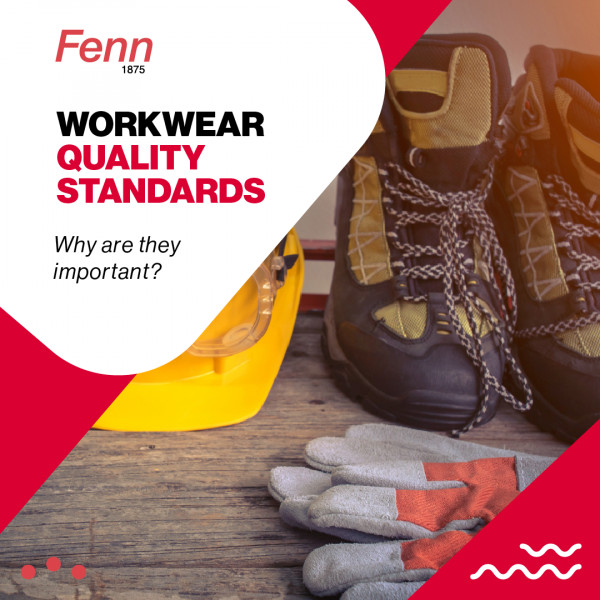Ensuring your team has the right uniform can be difficult when certifications and quality standards come into play. Not only are you concerned about comfort, warmth, durability and in some cases branding - international health and safety standards can further complicate workwear procurement!
We’ve put together a list of the main workwear quality standards and what they mean so you can purchase your workwear with ease…
EN ISO 20471 - High visibility clothing
This comes in three different classes, showcasing how adequately the garment offers protection. Three is the highest classification, offering the most protection. For the garment to meet the ISO 20471 standard, all reflective parts must reach at least class two with the ability to reflect light. Clothing with this standard must be tested after washing to ensure the materials are durable.
EN 17353 - Workwear with enhanced visibility
This clothing class is not as strictly monitored as the ISO 20471 which is designed to be worn in more high risk areas. However it is still important to note that EN 17353 clothing is designed to be worn in medium to high risk environments and is essential for the visibility of employees.
EN 342 - Protection against cold temperatures
Working in cold temperatures isn’t pleasant and can cause serious health problems if adequate protection isn’t worn. Choosing garments at the standard of EN 342 will ensure protection - but the overall uniform is important too! Considerations around insulation, waterproofing, permeability and any accessories like gloves, boots and hats to stop losing heat.
EN 343 - Breathable, wind and waterproof clothing
This clothing class is versatile and designed to keep you safe and warm whatever the weather. Some jobs need to be carried out in snow, torrential rain or heavy winds - so ample protection needs to come from the workwear your team is wearing. Again there’s three classifications for protection and three is the highest. This is shown in the two values next to the visual - the first indicates waterproofing and the second indicates breathability.
EN ISO 11611 - Protection when welding
This standard specifies the minimum requirements for protective clothing needed for welding or performing similar tasks with comparable risks. This time there’s only two classes, one and two, with class two being the highest.
EN ISO 11612 - Protection for clothing against heat and flame
This certification is for the flexible materials used to make coveralls to protect the body, not hands and face, from heat or flames. With the exception of hats and gaiters, garments for the protection of the head, hands or feet are not covered under this criteria.
EN ISO 14116 - Protection for materials against heat and flame
This certification specifies the performance requirements for materials, material combinations and items of protective clothing with limited flame spread properties. These are designed in order to reduce the likelihood of the clothing catching fire and limiting the risk of a hazard.
IEC 61482-2 - Live working
This symbolises clothing that will protect against the thermal hazards of an electric arc. The certification involves two test methods.
The first test method: open electric arc tests the fabric and garment in order to determine the ATPV/EBT value of the clothing.
The second method: a box test determines the electric arc protection class of the fabric and the garment through the use of a forced and controlled electric arc. There are two different classes, with class two being the highest and offering the best protection.
EN 1149-3 & EN 1149-5 - Protective clothing with electrostatic properties
These certifications are for protective clothing with electrostatic properties.
EN 1149-3 - electrical discharge
This standard is for the breakdown of electrostatic charges from the surface of the clothing materials.
EN 1149-5 - materials performance and design
This certification ensures the requirements for the materials and design of electrostatic dissipative protective clothing. These garments are then used as part of a grounded system to prevent incendiary discharges.
EN 13034 (Type 6) - Protective clothing against liquid chemicals
This certification is for PPE clothing that will provide limited protection while working with and around liquid chemicals. As these garments only offer limited protection, they’re best to be used in places where contact with chemicals is limited to low volume splashes and sprays.
EN 13758-2 UPF 40+ - Protection against UV rays
Products sold with this certification provide protection against the sun’s rays - both UVA and UVB. The products are labelled with an Ultraviolet Protection Factor (UPF value), which corresponds to the protection capability.
For example, a UPF 20+ factor indicates that a maximum of 1/20 of the sun's harmful rays penetrate the clothing. This means you can expose the protected skin to the sun's rays 20 times longer than you would without protection. The highest UPF label that the clothing can carry is UPF 40+, which corresponds to a maximum penetration of 2.5% of the sun's harmful rays.
It’s important to note that the protection capability is reduced if the product becomes worn, if the care instructions are not followed or if the clothing becomes wet.
For more information on workwear classifications, email us at This email address is being protected from spambots. You need JavaScript enabled to view it.
